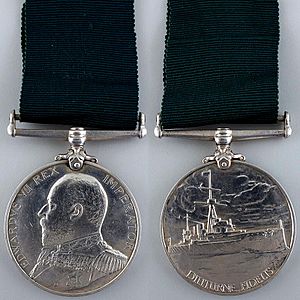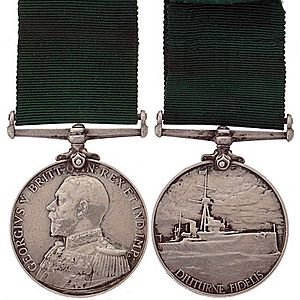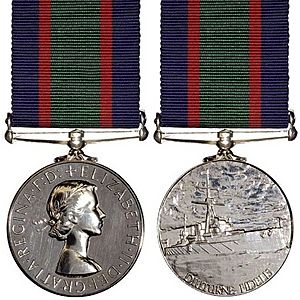Royal Naval Volunteer Reserve Long Service and Good Conduct Medal facts for kids
Quick facts for kids Royal Naval Volunteer Reserve Long Service and Good Conduct Medal |
|
|---|---|

King Edward VII version with original all-green ribbon
|
|
| Country | |
| Type | Military long service medal |
| Eligibility | Part-time ratings of the Royal Naval Volunteer Reserve |
| Awarded for | Twelve years service |
| Status | Still current in New Zealand |
| Clasps | Twelve years additional service |
| Statistics | |
| Established | 1908 |
| Order of wear | |
| Next (higher) | Royal Naval Reserve Long Service and Good Conduct Medal |
| Next (lower) | Royal Naval Auxiliary Sick Berth Reserve Long Service and Good Conduct Medal |
Original and post-1919 ribbon bars |
|
The Royal Naval Volunteer Reserve Long Service and Good Conduct Medal was a special award created in 1908. It was given to people who served part-time in the Royal Naval Volunteer Reserve (RNVR) in the United Kingdom. These were civilian volunteers who helped the Navy.
To earn this medal, a person needed to serve for twelve years and show good behavior. It was similar to other medals given for long service in the military. This medal was also awarded to part-time sailors in other parts of the British Empire, like Canada and New Zealand.
The United Kingdom stopped giving out this medal in 1966. This happened when the Royal Naval Volunteer Reserve joined with the Royal Naval Reserve, which was made up of sailors from the Merchant Navy. However, a similar version of the medal is still awarded in New Zealand today.
Contents
The Royal Naval Volunteer Reserve Long Service and Good Conduct Medal was created to recognize dedicated service. It was specifically for those who volunteered their time to support the Royal Navy. This medal showed that a person had served for a long time and had a good record.
Why was this medal created?
Before this medal, there were other awards for long service in different military groups. For example, the Volunteer Long Service Medal was for the army's volunteer force. In 1908, the Royal Navy decided to create its own special medals. These were for their part-time sailors. One was for the Royal Naval Reserve (Merchant Navy sailors). The other was for the Royal Naval Volunteer Reserve (civilian volunteers).
When was the medal officially started?
The Royal Naval Volunteer Reserve Long Service Medal began in 1908. It was for part-time sailors in the United Kingdom and other British countries. Later, between 1936 and 1941, its name changed to include "Good Conduct." This made it the Royal Naval Volunteer Reserve Long Service and Good Conduct Medal.
The medal looked exactly like another naval long service medal. The only way to tell them apart was by the letters on the edge. This medal had "R.N.V.R." on its rim.
How did the medal change over time?
At first, the medal hung from a plain dark green ribbon. This ribbon was the same as the one used for the older Volunteer Long Service Medal. But in 1919, a new ribbon was designed just for this medal.
Also in 1919, a special "clasp" was approved. This was a bar that could be added to the medal's ribbon. It showed that someone had completed another twelve years of service. Later, in 1942, a small rosette could be worn on the ribbon alone to show a clasp had been earned.
Which countries adopted this medal?
Several countries in the British Empire also started awarding this medal:
- South Africa began using it in 1915.
- New Zealand adopted it in 1925.
- Canada started awarding it in 1938.
How to earn the medal
To get the Royal Naval Volunteer Reserve Long Service and Good Conduct Medal, a part-time sailor needed twelve years of effective service. This service did not have to be continuous. During wartime, each year of service counted as two years. This helped sailors earn the medal faster.
A famous fictional character, James Bond, was even said to have received this medal for his service!
What does the medal look like?
The medal is made of silver and is about 36 millimeters wide. It has a raised edge on both sides. The medal hangs from a silver bar at the top.
The front of the medal
The front of the medal shows a picture of the reigning King or Queen. There were seven different versions of the medal made over the years. Each version featured a different monarch:
- King Edward VII (1908 version) showed him in his Admiral of the Fleet uniform.
- King George V (two versions, from 1910 and 1931) also showed him in uniform or with a coinage-style image.
- King George VI (two versions, from 1936 and 1949) featured his coinage-style image. The first King George VI version was the only one awarded in Canada.
- Queen Elizabeth II (two versions, from 1952 and 1953) showed her coinage-style image. The second Queen Elizabeth II version had its hanging part made in one piece with the medal.
The back of the medal
The back of the medal shows a picture of HMS Dreadnought. This was a famous Royal Navy battleship that started service in 1906. Below the ship, it says "DIUTURNE FIDELIS." This Latin phrase means "Faithful Over Time" or "For long and faithful service."
The clasp and ribbons
The clasp is a silver bar with a leaf design. It was attached to the medal's ribbon to show extra service.
Two different ribbons were used with the medal:
- The original ribbon was dark green.
- A new ribbon was introduced in 1919. It was 32 millimeters wide and had navy blue, dark red, and dark green stripes. The blue stood for the sea, the red for the Royal family, and the green for the original volunteer medal ribbon.
When the medal stopped being awarded
The Royal Naval Volunteer Reserve Long Service and Good Conduct Medal was gradually replaced by new medals in different countries.
- Canada stopped awarding its version in 1946. This happened when their volunteer reserve joined with the main navy reserve.
- South Africa replaced the medal in 1952 with their own award, the John Chard Medal.
- In the United Kingdom, the medal was discontinued in 1966. This was when the Royal Naval Volunteer Reserve merged with the Royal Naval Reserve. The medal was then replaced by the Royal Naval Reserve Long Service and Good Conduct Medal. This new medal required fifteen years of service.
However, New Zealand still awards a version of this medal today. It is called the Royal New Zealand Naval Volunteer Reserve Long Service and Good Conduct Medal. It is given for fifteen years of service, and a clasp can be earned for every ten additional years.






